#once and future richard iis
Note
Are there any notable examples of anti-mutant prejudice towards the X-Men coming from within the superhero community?
This is a great question!
This gets to the complicated nature of how mutants fit into the Marvel Universe. I've always been a vocal proponent of the idea that, far from the mutant metaphor only making sense if it's in its own little bubble where mutants are the only people with superpowers, the mutant metaphor actually functions better in the context of the Marvel Universe, because it allows you to explore more complicated and more subtle ways that prejudice functions.
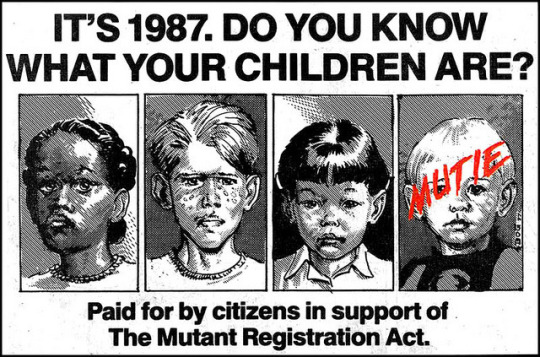
While there are plenty of super-villains who have quite blatant anti-mutant prejudice, you don't tend to get that same kind of overt bigotry towards mutants among super-heroes. Partly, this is because bigotry is a very unheroic character trait, but it also has to do with the way that the way that Marvel historically portrayed the spillover effects of anti-mutant prejudice.
Following in a kind of Niemöllerian logic, it's almost always the case that groups that hate and fear mutants also end up hating and fearing non-mutant superheroes. Thus, Days of Future Past starts with the Sentinels being turned on mutants, but it ends with the Sentinels wiping out the Avengers and the Fantastic Four too - because the same atavistic fear of "the great replacement" applies to both mutants and mutates. Likewise, the same forces that line up to push through the Mutant Registration Act inevitably end up proposing a Superhuman Registration Act, because once you've violated the precepts of equality under the law for one minority group, you establish a precedent to do it to another.
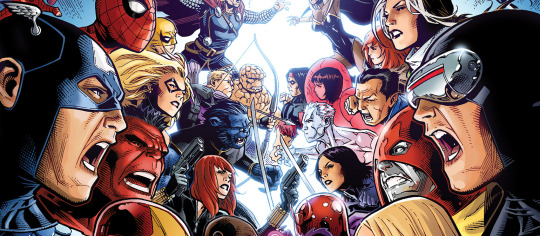
Instead, I would argue what you see in the case of anti-mutant prejudice among superheroes is explorations of liberal prejudice. This takes many different forms: in Civil War, you see Tony Stark insensitively try to wave the bloody shirt of Stamford in the face of a survivor of the Genoshan genocide or Carol playing the good liberal ally but ultimately trying to get mutants to set aside their own struggle in favor of her own political project. (For someone who's spent a good deal of time working, and living with, the X-Men, occasionally against the interests of the state, Carol does have a tendency to stick her foot in her mouth. Hence in Civil War II, you see Carol essentially goysplaining the dangers of creeping authoritarianism to Magneto.)
In Avengers vs X-Men, you see the Avengers acting like they know the Phoenix Force better than mutants and ultimately prioritizing the safety of mankind over the efforts of mutantkind to reverse their own extinction. This is where the "Avengers are cops" meme in the fandom comes from. (I would argue that Captain America is badly mischaracterized in the latter event - we know which side he's on when the interests of mutants and the interests of the state come into conflict.)
The common thread here is that anti-mutant prejudice among superheroes emerges as a kind of unthinking, unreflective callousness brought on by a worldview that thinks of humans as the universal default of lived experience - while thinking of mutants as a somewhat annoying special interest group that fixates on their particularist grievances rather than working for what the heroes consider to be the common good.

For a more intimate version of how this plays out, I think the Fantastic Four are a great exploration of how "well-meaning" liberals can massively fuck up when they don't do the work of examining their own biases. We've seen this since the very beginning: in Fantastic Four #21, Kirby goes out of his way to depict uber-WASP Reed Richards blithely assuming that the "free market of ideas" will take care of the Hatemonger, while the subtextually Jewish Ben Grimm knows that the way to deal with a mind-controlling Hitler clone wearing purple Klan robes is deplatforming-by-way-of-clobberin'.
Then later on, we see Reed Richards debate Congress out of passing a Superhuman Registration Act, while saying nothing about the Mutant Registration Act - even though he has a mutant son who is directly threatened by it. (See that adorable blond moppet with the slur scrawled across his face in the fictional advertisement above? That's Franklin Richards.) This is why I have a crack theory that Franklin's biological father is actually Namor rather than Reed, which is why Reed so consistently shows a passive-aggressive hostility to his son's mutancy.
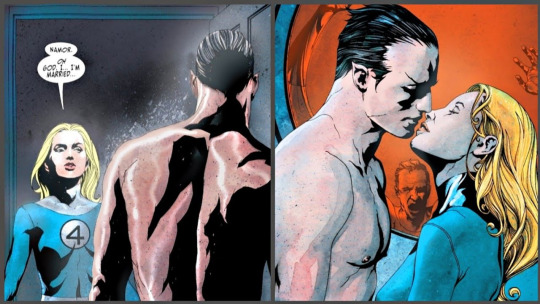
At the same time, Sue also has her blindspots when it comes to mutant rights. In the underrated FF/X miniseries, Susan Storm acts like an understanding and supportive parent to Franklin - right up until someone suggests that Franklin might want to come to Krakoa and explore his mutant identity, at which point she goes full Karen and starts lashing out with her powers. Chip Zdarsky, the writer, explicitly compared Reed and Sue to liberal parents who support gay rights in the abstract until their kid comes out as trans and wants to spend time in LGBT+ spaces.
106 notes
·
View notes
Text
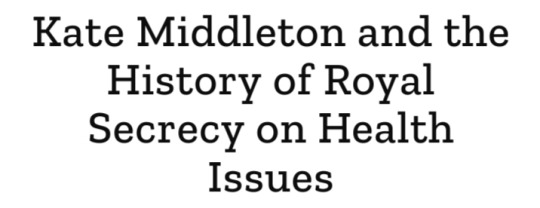
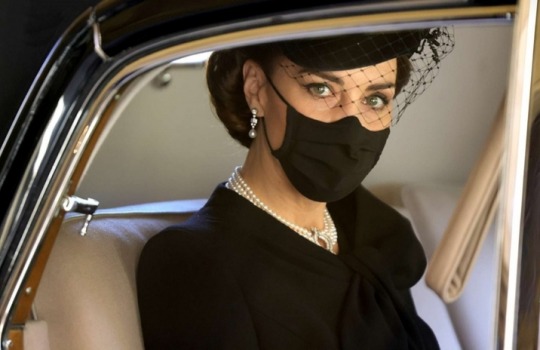
By Simmone Shah
29 February 2024
While Catherine Middleton has been absent from royal duties for two months due to a “planned abdominal surgery,” the British public has been full of speculation about what's going on with their future Queen Consort.
But the royal family has always held a fine line between balancing private health matters with disclosure to the public they serve.
“You could argue that details about a head of state are in the public interest,” says Richard Fitzwilliams, an expert on the royal family.
“But on the other hand, to what extent does a public figure have a right to privacy?”
Catherine's absence fits into a long and evolving history of how royals have chosen to handle health issues.
Past generations often shrouded them in secrecy. Perhaps most famously, in the 1950s, the British public was not told when King George VI had lung cancer.
In 1951, he had his left lung removed because of what was vaguely described as “structural abnormalities," and cancer was not mentioned in his death announcement.
Occasionally, past generations would be more open about less significant problems.
Once in 1982, when Queen Elizabeth, the Queen Mother, had to visit the hospital after nearly choking to death on a fishbone, she issued a statement to the press, joking, “It was only the salmon getting its own back."
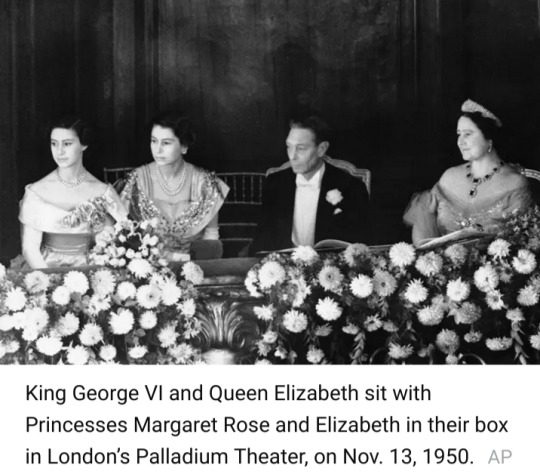
“The fishbone is quite revealing because they tended to be more open about minor instances,” says Gareth Russell, a historian and author who focuses on the British royal family.
“Britain was a much more reserved society in the 20th century, and in families across the land and across the social spectrum, cancer or fatal illnesses often weren't discussed.”
Catherine and William’s approach has proved to be starkly different, as they’ve addressed private matters with far more candor.
“Catherine and William are members of a different generation, so they feel no shame in being open about challenges,” says Clare McHugh, a royal historian and author.
Neither Catherine or William have shied away in the past from speaking out about health matters.
Prince William has spoken extensively about the importance of mental health, and Catherine spoke about the difficult morning sickness she faced during her pregnancies.
She also revealed her postpartum baby bump in photos hours after giving birth to her son, Prince George.
In part, it’s a necessary tactic for the internet age in which secrets are much harder to keep.
“I think they do recognize that in order to survive and flourish in a modern era they need to be honest about what is going on with them,” says McHugh.
“It’s better for them to be candid up front rather than let internet rumors fly.”
That they have previously been somewhat transparent only makes their current silence stand out, experts say.
“That’s why William and Catherine’s reticence about what's going on with them is odd,” says McHugh.

As Kathryn Lamontagne, a lecturer in Social Science at Boston University says, sometimes saying nothing causes more of a stir than addressing the problem head on, a lesson the Royal Family learned when Queen Elizabeth II missed parts of a major event in the months before her death.
“For Royal followers, her absence from the Platinum Jubilee celebrations in 2022 was a glaring sign of how unwell she was and a clear indicator of a serious issue on the horizon,” Lamontagne said in an email.
Still, despite her candor in the past, in many ways the Duchess of Cambridge’s silence is simply following tradition.
“This dance between private and public information nudges the line of medical privacy and a public clamoring for details, but it still follows the pattern of giving very few medical details of a certain kind to the public,” says Lamontagne.
“‘Never complain, never explain,’ in the words of the late Queen.”

#Princess of Wales#Catherine Princess of Wales#Catherine Middleton#Kate Middleton#British Royal Family#health issues#abdominal surgery#right to privacy#King George VI#Queen Elizabeth the Queen Mother#Prince William#Prince of Wales#Queen Elizabeth II#medical privacy
23 notes
·
View notes
Text


I . Who am I? Who am I? I’m awake when you sleep at night. Who am I? I’m the dark underneath the light. Who am I? I’m the space living in between. Who am I? I’m the one thing in everything. I, who am I? I’m a saint, I’m a sinner. I’m a God, I’m a killer, I’m the end and the beginner. Who am I? ( Who am I? ) Watch and learn, then you live and die. ( Who am I? ) I’m what’s waiting on the other side. ― Tony22, Who Am I?
II . Shall we look at the moon, my little loon? Why do you cry? Make the most of your life, while it is rife, while it is light. Well, you do enough talk, my little hawk. Why do you cry? Tell me, what did you learn from the Tillamook burn? Or the Fourth of July? We're all gonna die. ( We're all gonna die. We're all gonna die. We're all gonna die [ ... ] ) ― Sufjan Stevens, Fourth of July
III . I am alive, I am awake. I am aware of what light tastes like. The curtains drawn, the table's set; I wanna be, I wanna be, at my best. It's bittersweet, it's poetry. Careful pruning of my dead leaves. It's holy ground, a treasure chest; I'm on my knees and only scratch the surface. Like fists unraveling, like glass unshattering. Breaking all the rules, breaking bread again. Swallowing light, 'til we're fixed from the inside. ― Sleeping At Last, Taste
IV . And everything that's here is rising in tone and saturation. It's an aching, it's a violence. It's a longing to erase the separation. [ I DON'T WANT TO BE HAPPY, I DON'T WANT TO BE GOOD [ ... ] I WANT TO BE REAL. ( I WANT TO BE REAL. ) ] Looking up at me with hearts around your eyes, stretching arms to beckon me back to that bed. It's the quiet place where everything that's warm and real inside of me still lives. Break your crown and throw it tumbling to the Earth. Burn the gates of heaven down if it's real. Soak me in my mother's blood, show me that your arms can hold me, dive into the dying light and find me here. ― Crywolf ft. Emalyn, TENEBRESCENCE
V . The ashes call my name. Pouring the fuel, fanning the flames; breaking the habit and melting the chains; embracing the fear, chasing the fight. The glow of the fire will light up the night. The bridges are burning, the heat's on my face. Making the past an unreachable place. Pouring the fuel, fanning the flames, I know this is the point of no return. It's uncontrollable, such a beautiful desire. There's something sinister about the way it hurts when I watch it burn ( higher and higher ) because I can't go back. ― STARSET, NO POINT OF RETURN

I . When I choose to see the good side of things, I'm not being naive. It is strategic and necessary. It's how I've learned to survive through everything. I know you see yourself as a fighter. Well, I see myself as one too. This is how I fight. ― Waymond Wang, Everything Everywhere All At Once ( 2022 )
II . I’ll rewrite this whole life and this time, there’ll be so much love, you won’t be able to see beyond it. ― Warsan Shire, Backwards
III . Part of heroism is being able to see the future and still remain standing. If you don’t believe in God or Fate, you still must believe in Narrative. ― Richard Siken, Four Proofs
IV . My God, my God, whose performance am I watching? How many people am I? Who am I? What is this space between myself and myself? ― Fernando Pessoa, The Book of Disquiet
V . God said: GOD MADE YOU. GOD DOES NOT CARE IF YOU ARE " GUILTY " OR NOT. I said: I CARE IF I AM GUILTY! I CARE IF I AM GUILTY! [ ... ] God was silent. Everything was SILENT. ― Frank Bidart, Half-light: Collected Poems

#𓁹 ༑ ࿐ྂ ⩇⩇ : ⩇⩇ ⚠︎ [ 𝙴𝚇𝙸(𝚂)𝚃 : 𝙶𝙾𝙳 ] * ‹ STUDY . ›#𓁹 ༑ ࿐ྂ ⩇⩇ : ⩇⩇ ⚠︎ [ 𝙴𝚇𝙸(𝚂)𝚃 : 𝙶𝙾𝙳 ] * ‹ INSPIRATION . ›#𓁹 ༑ ࿐ྂ ⩇⩇ : ⩇⩇ ⚠︎ [ 𝙴𝚇𝙸(𝚂)𝚃 : 𝙶𝙾𝙳 ] * ‹ MICAH . ›#[ yeesssss we shall do this with the other main Starwakers of course but for now... Micah Time ( as we revamped this post ) <3 <3 <3 ]
9 notes
·
View notes
Text





La Peregrina, A Queen Among Jewels
Pear-shaped and weighing in at a magnificent 223.8 grains of 55.95 carats, Phillip II of Spain's wedding gift surpassed every fantasy his bride, the newly crowned Mary I of England, could have imagined. Baptized La Peregrina (an expression from the groom's native language meaning "female wanderer"), the brilliant pearl was delivered directly to the queen, its priceless value reflecting the inestimable importance that a marriage treaty between England and Spain represented at the time.
Found on the coast of Panama in 1513 by an African slave, the pearl went down in history as a fine adornment much appreciated by royalty. In her well-known official portrait of 1554, Mary is depicted adorned with her wedding present, dangling from a bejeweled brooch on her chest. Queen Margaret, wife of Phillip III of Spain, wore it during celebrations of a peace treaty with the English in 1605. Two of the wives of Phillip IV of Portugal and Spain also had the privilege of wearing it — but the jewel would still pilgrimage through Europe and the world, and would end up not just under the possession of princesses and queens, but of other distinguished personalities.
After the end of the 16th and 17th centuries, La Peregrina would be mentioned in the annals of history again only in 1813, when Joseph, brother of Napoleon Bonaparte, filched it along with a significant part of the Spanish Crown Jewels, in his flight from Spain back to France. After the fall of Napoleon in 1815, the pearl's new owner moved to the United States, where he would eventually die and leave it to his nephew, Charles Louis, the future Napoleon III. During his own exile, this time in England, the descendant of the Emperor of the French sold it to the second Duke of Abercorn, and it was actually during this period that the family heirloom received its infamous name.
The pearl would remain in the Abercorn family for a century, being briefly lost by falling from its setting twice — first, disappearing between the cushions of a sofa in Windsor Castle; then, during a ball at Buckingham Palace. Fortunately, La Peregrina was found and returned to her owners in both occasions.
In 1913 the jewel was cleaned and polished, and as a result, lost approximately 203 grams. Yet it still remains today the largest symmetrical pearl of its shape, and in 1969, after being auctioned at Sotheby's, it once again became a husband's gift to his wife. Richard Burton bought it for $37,000 for his wife, the iconic actress Elizabeth Taylor.
Interestingly enough, Taylor decided to adorn her gift with a completely new design, one inspired by none other than the regal portrait of Mary I. Other smaller pearls, emeralds and rubies completed the piece, centering around the glorious Peregrina, now displayed as a Tudor styled choker.
#tudor history#tudor queens#tudor dynasty#history#culture#tudor era#mary i of england#mary tudor#elizabeth taylor#tudorqueens#history facts#queen mary i
48 notes
·
View notes
Text
“The psychological investment of medieval English royalty in their children seems generally not to have been great. Yet the family life of Henry II, Eleanor of Aquitaine and their children had more than most royal families’ share of hostility. The stormy relationship between Henry II and his sons is almost a classic example of father-son relations in feudal society. They saw him preventing their attaining full manhood with lands and authority of their own, and their resentment pushed them into rebellion. Henry was a restless man with a violent temper, and his sons often bore the brunt of his impatience and anger. The estrangement between Henry and his queen by 1170 must have had an effect on their children’s feelings, and the couple’s hostility can account for some of the boys’ lack of affection for their father. Once they reached adolescence, they lacked any loyalty to him; and their rebellions gave a tragic quality to his last years. […]
William of Newburgh, a northern chronicler, wrote of Henry II’s ‘inordinate love for his sons’ and accused him of trampling on others’ rights ‘while he exerted himself unduly for their advancement’. Yet little concrete evidence survives for Henry’s feelings toward his children except his schemes for succession to his lands. It is difficult to know whether Henry II was applying any principle in his partition of his territories, whether he had any vision of the Angevin domains as a unity or viewed them simply as a block of family lands to be used to provide for his offspring. Henry gave his sons honourific titles in 1169 when they were adolescents, hinting at an ‘Angevin empire’ with at least a loose structure held together by family ties. His eldest son and namesake, crowned king of England in 1170 at age fifteen, was to have the Anglo-Norman realm together with greater Anjou (Anjou plus Maine and Touraine); his second son, Richard, was proclaimed duke of Aquitaine, when he was fourteen; and Geoffrey became count of Brittany through marriage at age eleven; along with his continental county went the English earldom of Richmond. Little John ‘Lackland’ had no place in this tripartite partition. Most scholars agree that Henry II followed feudal custom in rejecting strict primogeniture succession of Young Henry to all his domains; he had both Angevin and Anglo-Norman precedent in feudal law for his scheme. Probably Henry held the hope that as his sons grew up, he could share the governing of the Angevin domains with them, withdrawing from day-to day work into something like ‘the chairman of a family consortium’.[…]
The birth of John in 1166 exacerbated relations between Henry II and his older sons, for he did not want his lastborn to remain ‘John Lackland’. His periodic new schemes for partition of his empire angered Young Henry, Richard, and Geoffrey, feeding their jealousy of each other and of their youngest brother. Such schemes especially aroused Richard’s resentment once his elder brother’s death promoted him to senior rank among the sons. Any younger son had uncertain prospects; and since Richard and Geoffrey were ahead of John in any division of Henry II’s acquisitions, his prospects were even less certain. He must have known from literature and from his own family’s history that the youngest of several sons often got nothing. Twelfth-century vernacular poetry is filled with tales of younger sons forced to leave home to seek their fortunes as knights errant. Insecurity about his future, rivalry with his brothers and awareness of their resentment over his father’s schemes to find land for him must have influenced John’s character. No youth growing up in such an atmosphere of suspicion and treachery could fail to absorb some poisons.”
— Ralph V. Turner, King John: England’s Evil King?
15 notes
·
View notes
Text
Meet our contestants!
Seeding is in progress, the bracket should be done by tomorrow and Round One will begin! In the meantime send propaganda in the ask box!
List of the nominees under the cut:
Adora from She-Ra and the Princesses of Power
Aragorn from The Lord of the Ring
Ari Helix from Once and Future
Arthur from Code Geass
Arthur from Arthur King of Time and Space
Arthur from Shrek 3
Arthur from Disney’s The Sword in the Stone
Arthur Boyle from Fire Force
Arthur Dent from The Hitchhiker’s Guide of the Galaxy
Arthur King from King Arthur and the Knights of Justice
Arthur Kingsmen from Mystery Skull
Arthur Liebowitz from Fairy Odd Parents
Arthur Lester from Malevolent
Arthur Pendragon from BBC Merlin
Arthur Pendragon from Kaamelott
Arthur Pendragon from Seven Deadly Sins
Arthur Pendragon from The Mechanisms “High Noon over Camelot’’
Arthur Read from PBS’s Arthur
Bob from the Minion
Dave Strider from Homestuck
England from Hetalia
Excalibur from Soul Eater
Firestar from Warrior Cats
Fjord Stone from Critical Role
Flynn Carson from The Librarians
Jack and Annie from the Magic Tree House
Jim Lake Jr from Trollhunter Tales of Arcadia
John Uskglass from Jonathan Strange and Mr Nobell
King Arthur Baking Company from real life
King Arthur from Gargoyles
King Arthur from Monty Python and the Holy Grail
King Arthur from Quest for Camelot
King Artorius from Wizard 101
King from The Owl House
Ky Kiske from Guilty Gear
Larry the cat from real life
Link from The Legend Of Zelda
Little Josh from the Josh Figh
Lord Foog 2nd from internet meme
Lucille Kensington from Where the Stars Fell
Magnus Burnsides from The Adventure Zone
Martin the Warrior from The Redwall Series
Merric from Fire Emblem
Mario from Nintendo’s Paper Mario
Peter Pevensie from The Chronicles of Narnia
Poptropica Player Character from Poptropica
Prince Marth of Altea from Fire Emblem
Queen Elisabeth II’s ghost from real life
Rand Al’Thor from The Wheel of Time
Richard Campbell Gansey III from The Raven Cycle
Roland Deschain from The Dark Tower
Saber Artoria from Fate/Stay Night
Sailor Venus from Sailor Moon
Simon Snow from Carry On
Sonic the Hedgehog from Sonic and the Black Knight
Sora from Kingdom Heart
Stabby the Roomba from real life
Tedros from the School for Good and Evil
The lettuce who outlasted Liz Truss from real life
The little swedish girl who found a thousand year old sword in a lake from real life
The Luidaeg from The October Day Series
Thomas the Tank Engine from Thomas King of the Railway
Wart from The Once and Future King
Zagreus from Hades
28 notes
·
View notes
Text
II Drabble for @vxctorx
Boyish, blue orbs waltzed a delicate balance of hasty yet purposeful glances upon the roughened facade of his sketchpad's parchment, now etched with meticulously drawn ribbons and curves of ebony and ashen shades, and the golden image of his love's reclined figure. The honeyed tones of tender sunbeams and the sea's untamed locks rapping upon the distant shore perfectly accompanied such a waltz.
"Just continue lyin' just like tha'... Aye, tha's righ'. Just keep tha' hand of yer's framed close to yer' face. I promise I'm almost done, just a few more touches, is all." Oh, how Vic was born to be an artist's muse (not that Richard counted himself as much of the former). The auric bends of his muscles, tied together with his princely crown of tawny curls that Richard had raked with wandering fingers a hundred times over; and not to mention the captivating splash of teal concealed in such a handsome gaze. The sort of gaze that Richard would recognize out of a crowd of thousands. The sort of gaze he would recognize in the depths of darkness. Such godly traits would be enough to make Apollo blush. "Have I e'er told ye' tha' I always wanted to go to art school. Ended up becomin' a fanciful dream, I suppose," he tut, as poised fingers weaved the sketcher's charcoal upon the final flourishes.

He could feel the round of his heart cuff against the walls of his chest. A misplaced pulse trapped against his throat now, which he silently tried to swallow back. "Y'know, I realized I've collected way too many fanciful dreams, and endorsed certain realities mainly 'cause I was expected to do so or... maybe even 'cause I was too much of a coward to figh' for wha' migh' actually make me happy." He paused. ".... It's time to put an end to tha'...." Since the weeks leading up to their seaside holiday, Richard had been wrestling with this notion, which eventually bloomed into something of a confession in his busied mind. One ripe enough that the plump of its cheek would break off from its stem on its own accord and tumble against entwined roots.
Richard lowered the barrier of his sketching pad, his blue eyes-- now brimming with the excitement of hope, the fear of refusal, and, mostly, the amount of overpowering love and affection he held for this man before him. His love. His future. His everything.
Placing his materials down, he drew forward before taking a seat beside his beloved; his warm hand, now lightly freckled with echoes of their previous, sunsoaked days, clasping Vic's. "Before I say wha' I've been wantin' to ask ye', I need to tell ye' tha' I got a job in London... Or, at least I applied for one, but rumour is tha' the position's as good as mine. Aye, it's not anythin' fancy like bein' a lawyer or bein' a gen'leman but it's a start; and, more importantly, it's certainly enough to buy a wee flat, and food, and clothes, and a new life. Our new life!"
Our new life. Ours. Oh, how that word tasted all the more sweet now that he was saying it aloud.

His eyes crinkled into a fervid smile, as his adoring gaze remained transfixed in earnest upon Vic, as if he were the North Star amidst a night as black as tar. "Come away with me, Vic. Aye, I know, it's sudden and I don't have a ring I can offer ye' righ' now, but I'll work hard. Hell, I'll even put in two shifts. Three, if it means makin' sure ye' ne'er want for more." Fingers folded a little tighter round Vic's hand now. Youthful optimism radiated with every word the Scotsman spoke, placing what sliver of doubt he once held upon the backcloth of his mind's eye. "Just imagine, a new life away from Sco'land. A life in London! Ye' can be whoever ye' want to be and work in wha'ever job makes ye' happy, and, in time, we may just have enough to purchase Our own plot of wood. For our cottage," he cooed, Their evergreen dream never having strayed away from such ingenue beliefs. "Look, ye' don't have to answer me righ' away if ye' donnae' want to. I know wha' I'm askin' is no small feat. I just-... No ma'er how many times I played it out in my mind my life in London, my happiness, wouldn't be complete without ye'.-- To put it bluntly, I'm ready to finally be brave if ye' are too." Gentle lips kissed the gilded hills of the gentleman's knuckles. "Come with me..." Richard whispered against the other's skin, the taste of sun and brine still stained upon His skin.
".... Come with me...."
#vxctorx#//*excitedly and nervously places this drabble on ur doorstep* <3//#//im really sorry it got longer than expected luv buuuuut I still hope you like it nonetheless! :>//#//idk I just had such a clear image of Richard basically proposing to Vic to come away with him//#//after applying for his London job ghjdkshjg//#//once again i hope u enjoy! 💛🥰//#period;uni days;v#hes half my soul as the poets say;#//also richard is being the softest ray of sunshine rn i cantttt ;-;//
4 notes
·
View notes
Note
naturally the most popular boys' name among the Targs is Aegon (11 at total, 2 before the Conquest), but the second is... Daeron, at 6, and its popularity peaked during the second halve of Targ rule. Do you think there's a particular reason for that, both Watsonian and Doylist?
Clearly, I think, the first Daerons to be thought of by GRRM (and thus named as such) were Daeron I and Daeron II, since GRRM included them in the Appendix of AGOT (as well as brought up Daeron I in Jon and Benjen's early conversation). How GRRM himself came up with the name "Daeron" is of course unclear (though we can imagine, perhaps, the author playing around with "ae"-based names, and he had already come up with the almost-identical name "Dareon" for one of Jon's fellow Night's Watch recruits in the same book), as is why he decided to give these two Targaryens that name. It's probable, though, that the author may have wanted to bookend the Targaryens' incorporation of Dorne with kings of the same name (since he added in that Appendix that "Daeron [I] conquered Dorne, but was unable to hold it, and died young" while "Daeron [II] brought Dorne into the realm by wedding the Dornish princess Myriah").
Now, while I don't believe the author had thought of this whole backstory at the time he invented the two ruling Daerons, I tend to think the future King Daeron I was officially named after Queen Daenaera's father while quietly being named to undermine the "false Daerons" who cropped up during Aegon III's reign. Daenaera Velaryon was the daughter of Daeron Velaryon, one of Alyn Velaryon's captains whose ship the True Heart was sunk (with Daeron aboard) during Alyn's attack on the Braavosi in the Stepstones. It's not unusual to have a grandchild named after a grandparent, and Daeron Velaryon’s participation (and death) in Alyn’s battle gave him a sense of permanently preserved military glory befitting a royal namesake. However, this name may have also served to emphasize that there was only one true Prince Daeron with a right to the throne in Westeros - not the false pretenders claiming the identity of Viserys I's youngest son, but the eldest son of the reigning King Aegon III (compare, say, the future Henry VIII, who was given the title "Duke of York" at the age of three in 1494, in the midst of Perkin Warbeck's attempt to assert himself as the dead Prince Richard, Duke of York).
The future King Daeron II, for his part, may also have been named for the queen's father, or his cousin Daeron, or in response to these "false Daerons", or any combination of the above. Maybe Prince Viserys (because I tend to think of the naming of his grandson as Viserys' decision, one he wouldn't trust to his highly irresponsible son) wanted to emphasize that his senior grandson was going to be a loyal lieutenant prince to his future royal cousin, just as his own eldest son was named in honor of the ruling King Aegon. Maybe Viserys wanted to give an outward sign of favor to Queen Daenaera by choosing her dead father as his namesake (perhaps demonstrating that he was not going to be any sort of rival to her husband or sons). Maybe Viserys wanted to discourage any future "false Daeron" pretenders by confirming that the Targaryens felt confident in using the name "Daeron". We'll have to wait and see.
Since "The Hedge Knight" was published in 1998, it's probable that GRRM named Daeron "the Drunken" next. Raymun Fossoway explicitly notes in "The Hedge Knight" that "Daeron, he's named, after the king" - that is, King Daeron II, the ruling monarch in 209 AC - and I think this is a straightforward explanation both in and out of universe. Once again, a grandparent being used as a namesake is a logical explanation, and with Maekar already written as a strict and dutiful son, it's hardly surprising that Maekar would have chosen to honor his father by naming his eldest son after him. Too, because GRRM has often talked about the influence of English history on his writing of the series and the repetition of names in that history - joking that everyone is always named "Edward", "Henry", or "Richard" - I don't find it at all strange that he'd repeat Daeron II's name for one of Daeron II's grandsons.
I can't say for certain when GRRM came up with the idea of Prince Daeron, the son of King Viserys I, other than it was no later than 2013 (when "The Princess and the Queen" was published). Likewise, why the author decided to go with "Daeron" as the prince's name is unclear. Perhaps he was thinking backwards from Daeron I; if he had decided even at this point that someday he would have a sort of false pretender narrative during the reign of Aegon III using a son of King Viserys, he may have thought to appropriate the name of Aegon's heir for this false pretender. Maybe the author liked the nickname "the Daring" and wanted an established Targaryen name that would provide some amusing alliteration. Maybe the author simply wanted a Targaryen name he had already come up with for Viserys' youngest son and figured "Daeron" worked as well as any other. Maybe all or none of the above. Nor did the author make clear in any of the historical works why Viserys I and/or Queen Alicent chose it as the name for their third son - but then, most Targaryen names go unexplained (we have no explanation for Aemond's or Helaena's names either, for example), so I wouldn't exactly put much stock in a lack of in-universe basis for the name. I think it's enough to assume that Viserys and/or Alicent wanted a Valyrian/Targaryen name for their son, that "Daeron" was an extant Valyrian/Targaryen name (if not seen in the Targaryens we know of before that time, certainly known by the Velaryons, since I think it's likely Daeron Velaryon was at least a little older than Prince Daeron), and that they went with "Daeron" accordingly.
Then we got TWOIAF and learned of two more Daerons: Prince Daeron, the third son of King Aegon V, and Prince Daeron, the short-lived second son of King Aerys II and Queen Rhaella. It's possible, of course, that GRRM had already decided on the name of Aegon V's youngest son even before publishing it in TWOIAF (given that he had Barristan Selmy refer to the unnamed "sons of the fifth Aegon" in ADWD, an indication that the author had at least to some extent fleshed out Aegon's family tree by that point). What the case is, I think it makes enough sense both in and out of universe that this Prince Daeron was named after King Daeron II. This name fits with the names of Aegon V's other sons in their namesakes: Prince Duncan after his close friend and longtime mentor Duncan the Tall, who had first educated him into the trials of smallfolk life, and Prince Jaehaerys after (presumably) King Jaehaerys I, the (at least publicly) wise Conciliator who had reformed the law and ruled with peace and justice. In certainly young Egg's mind, Daeron II "was a good king, everybody says so" and "a good man", who "brought Dorne into the realm and made the Dornishmen our friends" - in other words, a fitting model for the peace, justice, and universal prosperity Egg hoped to accomplish in his reign. Too, just as with Daeron "the Drunken", GRRM may have wanted to continue the historically inspired repetition of royal names within the Targaryen dynasty by having Egg pick "Daeron".
As far as baby Prince Daeron goes ... eh. Maybe it was after their uncle Prince Daeron, the dashing knight who had died nobly in battle when Aerys had been only seven (and who may have been preserved as a sort of ideal of knighthood in Aerys' mind thereafter). Maybe it was after King Daeron II or King Daeron I in testament to the highlights of their respective reigns. Maybe, like perhaps Viserys I and Queen Alicent, Aerys and/or Rhaella simply wanted a Targaryen/Valyrian name and thought that fit the bill. Or maybe they had a completely different reasoning. We'll probably never know. (And again, the point about GRRM pointedly repeating names stands.)
#asoiaf meta#names#namesakes#daeron i targaryen#daeron ii targaryen#daeron the drunken#daeron son of aegon#daeron the daring
52 notes
·
View notes
Text
Eleanor of Aquitaine- Grandmother of Europe.
(part II)
Second Marriage
When Eleanor returned to Poitiers, Henry II duke of Normandy ordered his younger brothers to kidnap Eleanor and claim her lands, however that was not needed,because Eleanor herself sent a messenger telling Henry to marry her at once if he wanted. On May 18 1152 the couple married in secret. However, Henry and Eleanor were even more closely related, while her first marriage was annulled due to Consanguinity. Even more, A marriage between Henry and Eleanor's daughter Marie had earlier been declared impossible due to their status as third cousins once removed and now he was marrying the mother of the previous refused match. The reason for the secret marriage was that Eleanor’s choice for her second husband was a problem: as the rulers of French vassal states, Henry and Eleanor needed permission to marry from the king of France, and there was little chance that Louis was going to approve the marriage, besides Eleanor met Henry in 1151, well aware of his claims to English throne and his wealth, she took certain interests in him, later historians claim that as seed of divorce was already sprouting that time, so future couple came to an agreement that once she was divorced they would marry, that would explain why they started to act immediately after divorce. However, the source those historians mentioned from Eleanor's contemporary scribe did not survive.
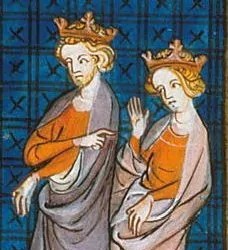
On October 25 1154 Henry became king of England and pregnant Eleanor was crowned queen on 19 December of the same year. On 28 February 1155 second child Henry the young was born, first child being William IX, Count of Poitiers. Over the next 13 years the coupe had 8 children, five sons and three daughters:
William (17 August 1153 – 1156)
Henry the Young King (28 February 1155 – 11 June 1183)
Matilda of England (June 1156 — June/July 1189)
Richard I (8 September 1157 – 6 April 1199)
Geoffrey II duke of Brittany ( 23 September 1158 – 19 August 1186)
Eleanor, queen of Castile (1161– 31 October 1214)
Joan queen of Sicily (October 1165 – 4 September 1199)
John Lackland (24 December 1166 – 19 October 1216)
Despite so many children Henry was by no means faithful of Eleanor and had numerous mistresses and illigitimate children. While Eleanor resented Henry's mistresses, she certainly had no hostility towards their children as when Geoffrey of York was acknowledged the Queen took him under her care.
Marriage has other problems as well, both parties were highly political, ambitious and stubborn. Aquitaine openly rejected the authority of Henry and declared that they would obey only the rightful duchess. After the third marriage and widowhood of Eleanor's first husband, marriage between "Young Henry" and Margaret of France was arranged,that is thought to be the last known co-operative decision of the couple,because after 6 following years of constant arguing,conflicts and power play, marriage was finally stained per Eleanor's discovery of Henry's affair with Rosamund the fair. Following the marriage of Matilda, third daughter of Henry and Eleanor, in 1167 Eleanor returned to Poitiers.
Court at Poitiers
While residing at her home, she hosted a legendary court. Most of the stories are just folklore and rumors, it is obvious that she was a great patron of art,poetry and literature. However, the famous "court of love" is mostly rumor. First of all, Courtly love was widely popular in France even before her birth,which I mentioned was the reason of her birth in the first place, therefore she could not have "invented" it as some mention. 12th century author Andreas Capellanus, a famous admirer of love of his time, mentions how Eleanor and her daughter Marie, listened to young lovers, acted as jury and supporting love out of wedlock as heartbroken queen rejected the coexistence of love and marriage. However, this is pure fiction created by Capellanus,as Marie and Eleanor did not spend that much time together, but it's based on Eleanor's actual support of teaching manners and kind of creating "etiquette" regarding treatment of spouses.All that can be said is that her court at Poitiers was most likely a catalyst for the increased popularity of courtly love literature in the Western European regions.

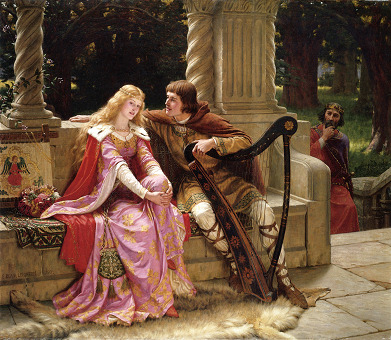
Different paintings inspired by the court of love.
Involments in Rebellion (1173-1174)
In 1173 the young Henry(junior king of England from 1170) started the Rebellion against his father, which Eleanor supported. The young king went to Aquitaine where Eleanor and his two younger brothers Geoffrey and Richard resided. Contemporary historian Roger of Hoveden claims that the queen sent her younger sons to France "to join with him[Henry the young] against their father the king."Once her sons had left for Paris, Eleanor encouraged the lords of the south to rise up and support them. In 1174 Eleanor herself left Aquitaine,but was captured and imprisoned by her husband. Young Henry was pardoned as, likely due to the involvement of Eleanor and Henry himself not wanting to punish sons, blame was put on barons,who were punished for manipulating young prices to do the evil deed.
Imprisonment
From 1174 to 1189 Eleanor spent her life as a prisoner. She was put under the house arrest in various English palaces,where she was under supervision of the king. She was permitted to see her sons only during special occasions, namely Christmas. That is the time she grew particularly estranged to her husband and favourite son Richard. During the first nine years of imprisonment she was minimally active in politics, but when King's mistress Rosamund the fair suddenly died in 1176 under quite mysterious circumstances, rumors rose that it was Eleanor who arranged her death by poisoning. Legend has it that Eleanor sneaked into her rooms and offered her to die either by dagger or by poison, which she eventually chose. Other legends say that she was roasted alive between two fires or her arms were cut off in the bath. However, all of them appear either in the 14th century's "French chronicles of london" or during Elizabethan era tales and balades, so they can not be true, however considering no recorded disease or accident around Rosamund,it seems quite sensible that Eleanor, who had certain freedom, could have bribed one of Henry's servant to poison her. The theory is the oldest, appears in the early 13th century, little time after Eleanor's death. It's justified by Rosamund's fault in estranging the couple and Henry's supposed plans to use Rosamund to force Eleanor into divorce. What really happened is unknown and the incident was quickly forgotten.
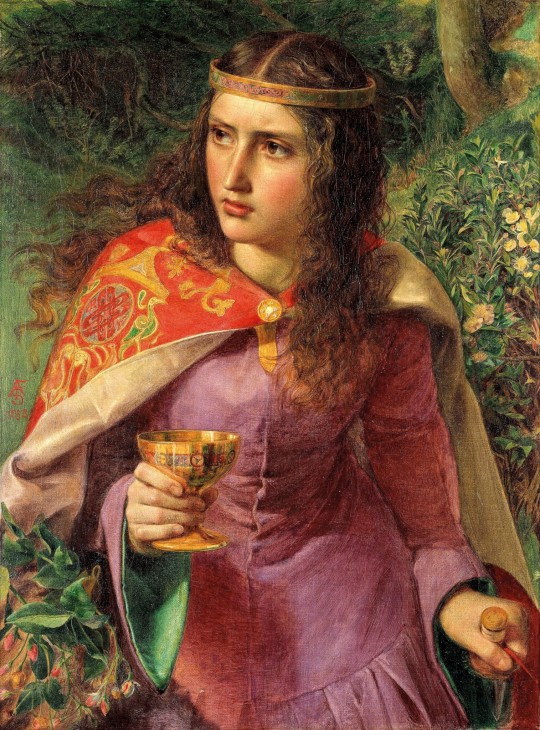
Queen Eleanor as depicted by Frederick Sandys. We can see her carrying a bowl of poison and a dagger.
On Saturday, 11 June 1183, the young king realized he was dying and was overcome with remorse for his sins. When his father's ring was sent to him, he begged that his father would show mercy to his mother, and that all his companions would plead with Henry to set her free. So Eleanor was set free and permeated to see her son one last time.Her major rise to power started in 1183 when Philip of France demanded lands in Normandy,which was the property of deceased young Henry. However, lands in Normandy was Eleanor's prior passing it to son, so after his death it should have been returned to her, as a result, Henry summoned Eleanor and sent her to Normandy, where she spent several months,but returned to England in 1184, after that she was technically free,but under supervision. She would often accompany her husband and even took part in deciding some political affairs. Upon the death of her husband Henry II on 6 July 1189, Richard I succeeded, One of his first acts as king was to send William Marshal to England with orders to release Eleanor from prison. During widowhood she gained power she never had before.
The Queen mother
After her release Eleanor rode to Westminster and received the oaths of fealty from many lords and prelates on behalf of the king. She would then act as regent for her son,who was fighting long wars. On 13 August 1189, Richard left for Portsmouth. Later he was absent from 1190 to 1194 for crusades and later was in captivity of the holy Roman emperor. During that time Eleanor was an unofficial regent, overseeing any decisions made by council and even went to Austria to personally arrange the release of her son. Her influence is evident by letters to the Pope,the holy Roman emperor and the king of Castile. Richard died in 1199 and Eleanor then became a major force in the reign of John Lackland.under the terms of a truce between King Philip II and King John, it was agreed that Philip's 12-year-old heir-apparent Louis would be married to one of John's nieces, daughters of his sister Eleanor of England, queen of Castile. Eleanor, who was 77-78 that time, herself went to Castile to choose one of the princesses. Same year she was kidnapped by Hugh IX of Lusingan.(that was not the first and last attempt of kidnapping her, actually it was the third out of four known occasion), she however arranged her freedom herself. In Castile, she remained for two months and returned to England after choosing Blache as the bride. The trip is said to affect her health.

Despite reducing health and increasing age, intrigues were not ending in her life, the war broke between John and Arthur the son of Eleanor's second son Geoffrey. The reason for the conflict was the succession to the English throne. After Richard I died without an heir, the throne was supposed to pass to the following brother Geoffrey,who died before Richard,but had a posthanous son Arthur,who was heir over John. Eleanor however supported the claim of John, as a reason very familiar instance of her life took place, she was kidnapped...again. After negotiations she was released with the condition that she would withdraw from politics and go to nunnery(which could have been her own choice). She died soon after in 1204 and was buried with her second husband in Fontevraud abbey.
one of many of her achievements I would like to underline the most is her age. after giving birth to 10 child in 12th century,being imprisoned for 9 years in castle, went to crusades, traveled in Austria and castle in her late 70's, she still managed to live up until 82 years, almost twice as much as avarage lifespan of her time.
My next post is going to be about women in the Ottoman empire so...
6 notes
·
View notes
Text
Meynnart Wewyck’s workshop-part 6: Hidden in Recueil d'Arras
Sorry guys, I realised this months ago, and forgot to post it. In part 1, I mentioned the lost Scottish portraits by Wewyck, done c.1502-1503. They seem to have been lost, and we only have Receuil d’Arras(collection of drawings based upon actual portraits, done in c.1570) which shows us aproximately how they looked like.
We have drawing of James IV, Margaret Tudor, Henry VII and then very rubbed of Elizabeth of York.
But records from 1502 show one extra painting. Of future Henry VIII. It’d be probably THE oldest portrait of him! As child! But it is nowhere to be found. Or have we been looking at it this whole time?

And if you read further I’ll explain you why this drawing from Receuil D’Arras cannot be the Warbeck. 100%.
This is typical handwriting of Le Boucq, found all over the Receuil d’Arras:

And this is text labelling the drawing of Warbeck as him:

Absolutely no way this is the same hand, and I’d wager not even same century. It’s too readable for modern viewer.
Le Boucq didn’t know who it was. He never made any label for drawing. And let me remind you Le Boucq made the drawing about 70 years after Warbeck died. Cca 1570.
How could anybody even later than that recognize it as Warbeck? Based upon what?! It’s impossible!
It was an unknown male whose portrait was part of Scottish royal collection(that is clear because of drawings surounding it. First 21 drawings in Receuil d’Arras were from(in) Scotland, even though not all sitters of those paintings were. Lots of french and english royalty etc. Royalty often sent each other portraits. Long story short, lots of evidence to suggest it truly was Scottish section.)
And based upon it, somebody GUESSED that it is Warbeck!
It’s supposedly the only depiction of him we have surviving!
And it is not him! 100%.
The jewelry, the posture, it fits with Wewyck’s work and Tudor males so well!
Yes, the features are nicer-because kids tend to have softer features and Le Boucq’s drawings also add the softness(such was his style). It fits perfectly with Wewyck’s work. Just look through previous posts.
Also, how would Warbeck’s portrait survive in Scottish royal collection throughout many years Margaret Tudor was the Queen? She’d be certainly outraged at such display. It’s not make sense for her husband to keep the painting of now dead man of whom he had no use.
Like for Tudors it made sense to portray Richard III with broken sword-because that shows him as warrior who was defeated, thus more glory to Tudors for defeating him.(read my post Mistaken identity, if you don’t get why I assume rest of Richard’s portraits are not him.) But same doesn’t apply to Scottish royalty and Warbeck.
In Receuil d’Arras ‘Warbeck’s’ drawing is not even that far from rest of Wewyck’s work.
It’s Henry VII, then Elizabeth of York, then two drawings of Elizabeth I (from late 1550s it seems), then James IV, Margaret Tudor, then Bernard Stewart, 4th Lord of Aubigny; then drawing of Egyptian woman who once healed Scottish King, James II of Scotland and then supposed drawing of Warbeck.
Henry VIII was just 3 drawings away from his sister, the entire time!
Meaning that probably in c.1570, all those paintings were in same chamber or set of chambers when Le Boucq drawn them. They were not separated, even though by that point nobody could remember who the boy in the painting was.
(Probably because those 4 paintings by Wewyck were in same style. So people knew they belonged together. Just no longer who was in one of them.)
That it is boy might also explain why he is much bigger in current drawing than rest of his family. (or at least Le Boucq makes it seems so.)Some painters struggled with proportions of children, adn then sometimes made them ridiculously smaller or much bigger.Even though Margaret would be in her early teens when she got painted, she’d be still couple of years older than her younger brother, thus her features closer to adults.
(That was main information. If you’re interested into me rambling bit more about the other Scottish paintings by Wewyck you can read further. But to be honest i covered lots of it in part 1. If not I hope you’ve enjoyed this.)
Speaking of Margaret I’d like to clerify something. Records suggest she was painted by Wewyck twice. Once as English Princess, and 2nd time already as Quen of Scotland. Idk which one is in Receuil d’Arras.
1)Drawing of Margaret Tudor, Queen of Scotland, based upon portrait from c.1502-3:

But I belive we have idea how 2nd portrait looked. Family trees of James I show Margaret in en face with gable hood:

It’s also in several engravings. Each of them is of not great quality.
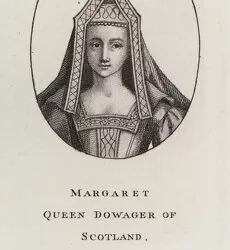
The lenght of frontlets and pitch of gable hood suggest it is early 1500s(max.1505), thus likely based upon Wewyck’s work.
I also wanted to point another thing about these scottish-based portraits. They are unique. While there are other depictions where they hold golden orb/apple? and similiar outfit, together all those details don’t fit any other different versions of their portraits surviving, probably because the copies made during Henry VIII’s reign were made based upon portraits located in England.
Thus Scotish located paintings never had copies of them made. So when alongside many other Scottish portraits they got destroyed, Receuil D’Arras became sole source where we can see them. (As far as we know.)
2)Drawing of Henry VII holding an apple/orb:

(Yep it is once again the same brooch-or perhaps there were 2 of same design but different sizes. But same style brooch.)
While even on Henry VII’s drawing some details of the sleeves rubbed off, note the shape of the oufit around his neck. It is round, and the curve goes downward.
And Henry VIII’s paintings go also downward.
But majority of Henry VII’s paintings, have it other way around. They are pointed upward. And it got me thinking-i don’t much about Tudor male fashion in general. So i don’t know their chronological order. However, around 1480 the neckline of english ladies was curve pointing downward(York sisters stained glass), but then through 1490s we saw W-shaped neckline pointing upward, which then slowly returned to almost straight line with slight raise by c.1500 and eventually to completely straight, only to be curved upward much later towards end of Henry VIII’s reign.
I don’t believe they’d send to Scotland painting predating Henry VII’s reign. It’s 1502 painting. No doubt about it.But neckline of men evolved in same way as ladies’ fashion, then big portrion of Henry VII’s paintings would not be from 1500s, but from 1490s, and I don’t mean just late 1490s. Thus potentially Wewyck worked for English royals for much longer than we assumed.
But I don’t have yet enough to establish firmly chronology of dress and headwear prior to 1500. Sadly my only solid source from that time are tomb brasses and dating of those is very difficult and requires lots of time.
3)Sadly Elizabeth’s sketch is no more there. Sketches are all in pencil and hers sadly got worn out. Only imprint of the original drawing left on the opposite page still survives, but it is really light imprint.@english-history-trip enhanced it a bit(far better than attempt I made and then discarded), but in order to know what that painting looked like, we have to flip it back:

It’s not perfect match with neither of the 5 paintings of her I showed you prior, Currently closest it comes to this:

But why if it is based upon original by Wewyck-from life, why is her neck short?
(In other cases it was in posthumous paintinsg or altered.)
This time there are other possible explanations alterations to the original, le Boucq not gettig proportions right(possibly further shifted by this being based upon imprint) etc. But imo none of those is correct. Imo it’s not alteration. It’s actually there, but isn’t what we think it is(neck crease). Imo it’s edge of necklace.
I had looked at original drawing in Receuil d’Arras, and in Photopea I played with setting to see, if i could find filter or something which would give us better idea of what the drawing looked like. I used both inprint and what is left from original drawing. That is how i discovered that just as Henry she held an orb.
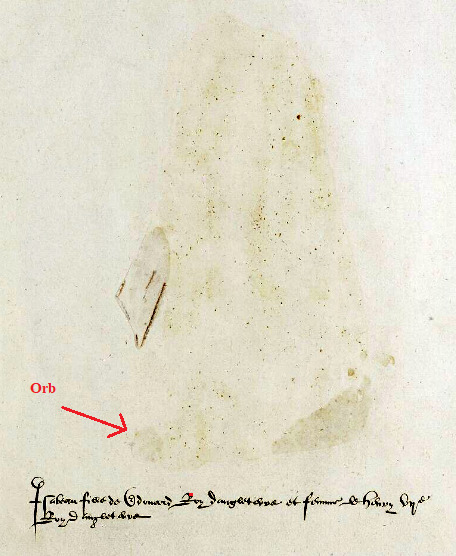
It just stayed on the original page and not on the imprint.
But to get to that necklace, I need to use much stronge filter. Idk what it is called with english, but it turns the drawing into these dots and as you shift the setting, it goes from very dark lines to very light ones-revealing some which you’d never see with naked eye. But it also has downsides. it will hide some lines you’ve seen before and eventually the filter will start to reveal weird lines which are texture of the paper, not related to drawing itself.

Main issue is that some parts are already distorted(because they were visible/more dark before), while some are not, and it is hard to catch the right setting for the era you’re interested in.

However you need to rely on your knowledge of tudor outfit, to connect the dots-literally and to know which dots to not remove.
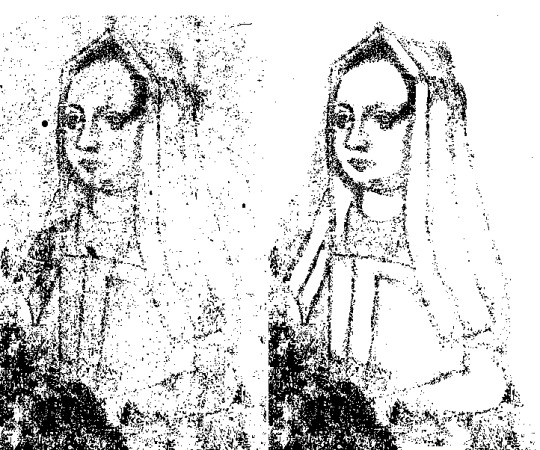
In this setting hands are not visible, but it is focused exactly on the area of clevage. Thus, while rest needs bit of clearing, that area should be fairly accurate. Now I could be wrong, but that looks like necklace to me.
And you can see it on imprint, in HD, if you focus on it. If you search for it. It’s very very light. But it seems to be there.

Tiny bit of pattern, just under the ‘neck crease) which forms shape of triangles I’d say. It’s not likely to be any of the pearl necklace of triangles we seen in late reign of Henry VIII and later. But some late 15th/early 16th century necklaces had similiar form. One is in Receuil d’Arass itself-on Eleanor of Austria as child:
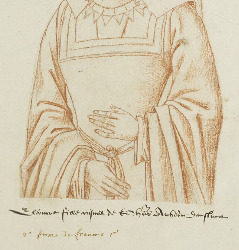
Royalty in those days often had same jewel makers. Just few provided the jewelry of quality royals wanted(that is why often you see same or similiar jewelry across Europe, on members of several different dynasties and it isn’t just them sending each other gifts.) Also fashion and jewelery back then was not solely unique to the country, they influened each other, and some trends took on in several countries or had pararels in them. (Like french hood’s frill and english gable hood’s paste in early 16th century- they moved up and down around same time.)
Thus Elizabeth’s necklace might have looked similiar to Eleanor’s. Idk exact shape, but it seems to me like top same, then much larger triangles. ANd sometimes it seems like two rows of triangles. Idk.
Unfortunately all my attempts looked horrible. You can try it yourself. I give up.

With hadns also. Can’t make the shape out conclusively. And i can’t make the shape out. But it sort of reminds me of necklace of triangles(which obviously was made much later) or some paintings at turn of 15th and 16th century. Nevertheless this is very underated depiction of her.
(I did look into drawing Henry VII also with these filters-because his is also partially rubbed off. He wears his usual clothes he has in many other portraits. There is nothing new for you to learn there.)
I hope you’ve enjoyed this.
7 notes
·
View notes
Text
The Nun II is already the highest-grossing horror film of the year

For the third consecutive week The Nun II leads the American box office, earning another 8.4 million dollars in a very weak weekend at the box office in the United States. In this way, the film has already achieved $69.2 million in the United States and a total of $204 million worldwide. A figure that makes this title the highest-grossing horror film of the year, surpassing the 188 million earned by Insidious: The Red Door or the 168 million earned by Scream VI.
The Nun II is a horror movie that was released in 2023 and is a sequel to the 2018 movie The Nun. The movie is part of "The Conjuring" universe and is directed by Michael Chavez, who has directed other movies in the same universe. The movie has received mixed reviews from critics and audiences. Some reviewers have praised the movie for being a fun and entertaining sequel, while others have criticized it for being boring and inconsistent.
Overall, it seems that opinions on the movie are divided, and viewers may have different experiences depending on their preferences for horror movies and their familiarity with The Conjuring universe.
youtube
The Nun II is a supernatural horror movie that follows Sister Irene, the protagonist from the first movie, as she investigates the murder of a priest in France in 1956. The plot of the movie is centered around the demon nun Valak, who Sister Irene once again confronts. The movie is set four years after the events of the first movie. The film may also connect The Nun universe back to the main chronology of The Conjuring universe, establishing what happens prior to Valak's appearance in the second Conjuring film. The movie is directed by Michael Chaves and written by Ian Goldberg and Richard Naing. The film also features new characters, including Antoinette, the 14-year-old leader of the group of bullies at St. Mary’s School who torments Sophie and others. The movie was released on September 8, 2023, and is produced by Warner Bros. Pictures and New Line Cinema.
Storm Reid is the actress who plays Sister Debra in The Nun II. She is a new addition to the cast of the movie and portrays a nun-in-training who gets caught up in Valak's evil plans. Storm Reid is an Emmy-nominated actress known for her roles in movies such as A Wrinkle in Time and The Suicide Squad.
Sister Debra is a significant character in The Nun II for several reasons. She is a nun-in-training who struggles with her faith, which is a central theme of the movie. Sister Irene helps her to find her faith and embrace her role as a nun. She witnesses Irene's confrontation with Valak and survives the ordeal, which strengthens her faith and resolve. She plays a key role in the movie's ending, which involves a twist that sets up the future of The Conjuring universe.
Overall, Sister Debra's character serves as a foil to Sister Irene, highlighting the importance of faith and the struggle to maintain it in the face of evil. Her character also helps to expand the world of "The Conjuring" universe and set up future movies in the franchise.
2 notes
·
View notes
Note
hello! speaking of eugène, do you know if sisi ever kept in touch with or referenced her beauharnais cousins, like the bernadottes or leuchtenbergs? do we know what she thought of them (if she did at all)?
Hello! This is something that I've also been wondering for a while. They did met sometimes with the Bernadottes, but I don't know if they treated each other as cousins. In Valerie's diary I found two mentions of them, first in 1885 in a letter of Franz Josef to Valerie about a visit of King Oscar II of Sweden (Josephine of Leuchtenberg's son and therefore Elisabeth and FJ's first cousin once removed). However I have no idea what the letter said because Richard Sexau, the guy that transcribed the diary in which the published edition is based off, decided to not transcribe it. The second mention is from 1886, when Valerie and Elisabeth were in Baden and met the Crown Prince Gustaf of Sweden (future Gustaf V, and grandson of Josephine of Leuchteberg) and his wife Crown Princess Victoria. The Crown Prince and Princess hanged out with them, Duchess Mathilde (Sisi's sister), and her daughter Maria Theresa "Mädi", whom apparently was close friends with Victoria (Valerie calls her "Mädi's beloved Viki" and also notes that she's very likeable). This is all I could find, but there probably is more.
I don't know about Elisabeth, but Archduke Max did kept contact with Empress Amelie of Brazil (Auguste and Eugène's daughter) even after Princess Maria Amelia (his fianceé) died. He visited her often, and I'm pretty sure they mentioned in each other's wills. Also I read in a biography of him that when he was Viceroy of Lombardy-Venice he tried to imitate Eugène, but I'm not sure how accurate this is.
About the rest of the Leuchtenbergs: Auguste, 2nd Duke of Leuchtenberg married Maria II of Portugal in 1834 but died shortly after without issue. His brother Maximilian, 3rd Duke of Leuchtenberg married Emperor Nicholas I's daughter Grand Duchess Maria Nikolayevna and moved to Russia, and for what I gathered eventually this branch loss all its connections to Bavaria. Eugénie (who was present at Sisi's birth and was one of her namesakes) married a prince of Hohenzollern; they visited Munich many times so maybe she met Sisi when she was more grown up, but she died in 1847 and had no children. And lastly Theodolinde, the youngest surviving daughter, married the future Wilhelm, 1st Duke of Urach, had four daughters and died in 1857. I know nothing more about this branch, but fun fact: Duke Wilhelm remarried and had a son, who later married Duchess Amelie in Bavaria, a niece of Empress Elisabeth.
#i would guess that the habsburgs did not treat the bernadottes as cousins because they were *gasps* protestants#but who knows maybe they did. no matter how intermarried your catholic dynasty is you WILL have a protestant cousin eventually#empress elisabeth of austria#archduchess marie valerie of austria#franz josef i of austria#empress amelie of brazil#maximilian i of mexico#oscar ii of sweden#gustaf v of sweden#queen victoria of sweden#house of bernadotte#house of beauharnais#asks
17 notes
·
View notes
Note
I don’t know about Becoming Elizabeth and why it’s trending, so I decided to do some research.
Becoming Elizabeth focuses on exploring the young future queen’s relationship with the older Sir Thomas Seymour, brother of her dad’s third wife, Jane Seymour, and the uncle of King Edward VI, who went on to marry Henry’s fourth and final wife, Catherine Parr. Elizabeth and Seymour were said to have had a romantic affair while the future queen lived with Catherine, who became Elizabeth’s guardian after the King’s death. On the show, Thomas is often seen hopping into Elizabeth’s bed, tickling her, and undressing her in front of the royal servants—all of which was documented in letters Reiss had read in preparation for the show. — The True Story Behind Starz’s Becoming Elizabeth
Are they romanticising Thomas Seymour and Elizabeth? I thought she was young at that time.
Thomas Seymour engaged in romps and horseplay with the 14-year-old Elizabeth, including entering her bedroom in his nightgown, tickling her, and slapping her on the buttocks. Elizabeth rose early and surrounded herself with maids to avoid his unwelcome morning visits. Parr, rather than confront her husband over his inappropriate activities, joined in. Twice she accompanied him in tickling Elizabeth, and once held her while he cut her black gown “into a thousand pieces”. — Elizabeth: Apprenticeship, p. 69
Elizabeth was 14-years-old. OH MY GOD. Also, she didn’t like his advances. If she liked it, why would she surround herself with maids every time he visits?
I’ve watched the STARZ’s The White Queen and I shipped Richard III and Anne Neville. They’re the only reason why I watch the show. And what did they do? Make Richard sleep with his niece, Elizabeth of York -- which is based on a rumor that he intended to marry her because his wife, Anne Neville, was dying and they had no surviving children.
In reality, King Richard III only loves his wife. Why else would he renounced Warwick’s land to George?
In order to win George’s final consent to the marriage, Richard renounced most of the Earl of Warwick’s land and property including the earldoms of Warwick (which the Kingmaker had held in his wife’s right) and Salisbury and surrendered to George the office of Great Chamberlain of England. — Richard the Third
After her death, he negotiates a double marriage with King John II of Portugal -- Richard with Joanna (Joan), and Elizabeth with their cousin Manuel.
Soon after Anne Neville’s death, Richard III sent Elizabeth away from court to the castle of Sheriff Hutton and opened negotiations with King John II of Portugal to marry his sister, Joan, Princess of Portugal, and to have Elizabeth marry their cousin, the future King Manuel I of Portugal. — “The Portuguese Connection and the Significance of the ‘Holy Princess’,” The Ricardian, Vol. 6, No. 90
They always do this, ruining real history for the sake of drama.
I think so many of us hoped that because Becoming Elizabeth wasn’t based on a PG novel and the show was not headed by Emma Frost that things would be different.
Apparently we were asking too much for Elizabeth’s abuse by Seymour when she was freaking fourteen to not be romanticized.
17 notes
·
View notes
Text
A tale of wars and mercy
Summary: Aegon II and Alicent in the future, so spoilers, obviously. This one gets depressing and dark with no smut or fluff but you've been warnd and should stop reading now :D English in not my first language, so please excuse any mistake in spelling and such.
“For God's sake, let us sit upon the ground
And tell sad stories of the death of kings;
How some have been deposed; some slain in war,
Some haunted by the ghosts they have deposed;
Some poison'd by their wives: some sleeping kill'd;
All murder'd: for within the hollow crown
Act 3, Scene 2”
― William Shakespeare, Richard II
Word count: 2,5 k
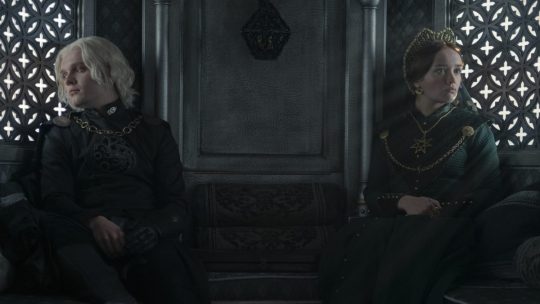
The barge doesn't land in King's Landing until after dark, and the fact that almost no one is moored in the harbor now is not lost on Aegon. It's cold and just like the last few weeks it's raining steadily. Once upon a time, when he was still a prince, he was welcomed more grandly in every brothel, but what does that matter now? He's one of the first to get out of the ship, teeth clenched and on crutches, but he makes it. By the time he reaches the carriage, he is almost screaming in pain and almost unable to see. He immediately gets on and the carriage starts off without waiting for anyone else.
He still breathes faster when he looks at his mother. He has no idea what he was going to say to her. They exchanged a few short letters before arriving. None of them were particularly personal, other than the news that his daughter was safe. He thought he hates Alicent for where all her willfulness had led them all, and that he would just spit venom at her. But now that she's sitting across from him... There are so many words on his tongue, but not all of them conceal a dagger. Am I less of a disappointment than Aemond now, mother? At least I'm still alive.
He takes a breath to tell her exactly that, but then, even in the light of the single lamp, he notices her reddened nose and tired eyes. The muscles in her face are tense, as if she hadn't slept all night. He is not surprised. The carefree summer of a few years ago is probably still in her dreams, and as soon as she opens her eyes, reality hits her like a hammer. And so Aegon swallows the words. There are things that even someone like him doesn't joke about.
His mother watches him carefully and immediately hands him a cup. "Drink," she says softly. It smells like milk of poppy and it makes his stomach turn.
"How considerate, but if you spent months in a fog thanks to that slime, you wouldn't even think of touching that again." Her voice and sometimes even her face are pretty much the only two things he remembers from that time. Nevertheless, he takes the cup - and throws it out through the ajar door. Only now does he notice how quiet the town is. They drive to Aegon's Hill through empty streets lined with looted shops and abandoned houses. Of course it is like that, he ponders.
“I hear no bells and fanfare, no one throws flowers and no one toasts me. Almost as if someone had something against our victory," he smiles wryly. "Was it worth it, mother?" he immediately gets serious.
"What do you want to hear? That if I could choose I would rather not hug your boys or hear Helaena's laugh? Of course I would change it. Satisfied, now that you've heard that?” She blurts out the words before regaining complete control.
"No." The tears that appeared in her eyes satisfied him more. He feels like a little boy again—another empty childish victory.
Mother sighs and raises her hand to his burnt face.
"I'm sorry," he tells her softly. He knows that he is unnecessarily cruel to her. She despises what he is. And she would die for him. She wanted to get him back to her as much as he wanted to get to her, more than he wanted to get back to that iron chair. After all, he was her first son and her last. "I know you're not well, but I'm even worse."
"Aegon, we won't…" Just then his mother's voice breaks. "We've both sacrificed a lot."
Years of youth, dreams, the possibility of having children with someone you love, sons, a wife, a father, your body being whole, a dragon…
“It's too late to change that, but we'll make sure everything we've lost was not for nothing, right? It all just has to have some sense of meaning," she places her palm on his.
"We can agree on that."
After all, how could they admit it was all for nothing and not go crazy?
***
Bodies hang from the walls of the Red Keep and it is decorated with impaled heads around which crows fly. He didn't care enough about these people to hate them. He doesn't even feel any particular hatred for his little nephew, he's just a quiet scared boy who had bad luck with his parents. But when his mother saw young Aegon, she pursed her lips and, with a wounded expression, ordered him never to see her again—he looked like a perfect blend of his parents. If they still didn't need him and it was up to Alicent, Rhaenyra's son is the first one to have his head removed. The very next day, Aegon's mother convinces him to be betrothed to Lord Baratheon's daughter.
Who Aegon really hates is the Sea Snake. He swore fealty to him, but the old man is so slippery that he would swear over and over and it was just words that he would choke on one day like on vomit. He hates Larys Strong too, who he thinks is playing a double game from the start, but how can he be sure before it's too late? Getting rid of him now could be as disastrous as throwing away armor in a battle.
Seven must be having a great time watching him now. Clinging to the throne with his teeth and nails, he crawled back to it, and even now he can't do what he really wants to do. Larys saved him, but at the same time, he may have given the city to his sister, thereby betraying him. Corlys Velaryon fought for Rhaenyra against the rightful king until the last moment. The brat, his granddaughter and that motherfucker's daughter attacked the king. Each of them in fact deserves an axe and yet... Aegon looks to the future with joy only when he imagines that there is nothing that a dagger cannot fix.
***
The bells ring on the last day of the year, and Aegon decides to celebrate and set off on a litter to the Dragon's Lair. He had over two hundred passionate supporters of the Shepherd rolled in tar and chained to the stakes, and now they are setting them on fire one by one to light the way for the king.
At the ruins of the Dragon's Lair, the Shepherd himself is chained amongst five dragon heads. Aegon expected something grander, but all he sees is a gaunt old man writhing in chains. The poor fool is babbling someting about seeing each other in hell before the year is over. Oh, so the Shepherd finally admits his sins. "You'd be waiting a long time for your turn," Aegon retorts. If Daemon Targaryen was victorious in battle, acquired a mistress, and died something of a heroic death, he himself certainly does not feel cursed for murdering his relatives and going to hell.
He takes a torch from one of the knights and sets the Shepherd on fire before quickly dropping the wood so it doesn't fall out of his hand. What's left of his muscles is already shaking with pain, and he listens to the Shepherd's screams for a few moments. It must be a relief to be so convinced of your own truth. Aegon wouldn't admit it to anyone, but he would quite like to believe that once he died he would no longer perceive anything at all.
***
Aegon is not merciful. As the lords of the Crownlands bow to him and swear allegiance and hand over hostages, his mother stands beside him, watching them with a stern expression. When done, she gives Aegon a weak smile and kisses his healthy cheek. It is strange to see her show so much affection to him, the son she loved the least. He is happy about it, even though he knows that his mother acts like this only because there is so little left that touches her heart at all.
Corlys Velaryon wants to speak with him that evening. "Your Highness," he begins cautiously, bowing his head in just a quick gesture. He suggests that Aegon should pardon all those who supported his sister - for the sake of the realm. "Even king Jaehaerys reconciled with those who supported his uncle Maegor."
“It's nice of you to pretend it hasn't dawned on you that I'm nothing like Jaehaerys. Tell me, Lord Corlys, did his wife, his children, and his dragon die because of their treachery, and did he end up a cripple? If that was the case, we can talk about how I should once again truly believe in some words and good will and give pardons generously.” Aegon pauses. "You haven't forgiven me either," she says without any hesitation
Corlys doesn't contradict him, just looks at him with something like regret for the first time. “If you see it that way, my lord. Some broken things simply cannot be fixed easily.'
Some broken things simply have too sharp edges.
***
Lord Corlys was right, the lords of the North, the Riverlands and the Vale decided to fight. And again he insists that Aegon should forgive them. Corlys insists that Aegon should name his nephew as his heir. Rhaenyra's son, of course. Corlys is still his sister's man - at least she didn't kill his wife. Aegon should betroth Rhaenyra's son to his daughter, as Queen Alicent had promised – Corlys says. And you believed her, you fool?
Aegon laughs it off at first – he didn't spill all the blood and lose so much for such a result.
That is until Larys Strong convinces him that such an arrangement would of course only be temporary and let Corlys have what he wishes. After all, Aegon is to marry Lord Baratheon's daughter. "Yes, I'm sure she can't wait to lay eyes on the prince of her dreams for the first time and to me to take her to bed," he laughs over the wine, his last joy. His laugh is a barking sound that sounds ugly even to him. He could almost see himself lying beside her with tears in the corners of his eyes, his bride watching him with frightened eyes, unsure of what to do.
***
Borros Baratheon has gone to battle and is probably the only one sure of his success. Enemies are just a stone's throw away from King's Landing and he is so full of confidence!
"My king, I hate to say it, but the truth should finally be heard," asserts Tyland Lannister.
The truth that no one around Aegon should have trusted him and he never should have trusted them either? He feels like a wounded pack leader whom the pack sacrifices at the first opportunity.
"I suggested the boy of theirs to be executed because as long as he lives, he will always be a threat," blind Tyland taps his nails on the table. "It did not happen. You don't want to hear it, but still - what exactly do you plan to do in case Lord Borros will not repels the enemies?'
Yes, exactly the question Aegon didn't want to address.
“If that happens, just surrender,” Corlys Velaryon suggests, as matter-of-factly as ever, as if it were a small matter. "Save the city, your people and yourself. If you give up the throne in favor of the prince, he will allow you to wear black and live in honor on the Wall.'
"Would he?" Aegon asks with some hope. But no, it would be a ridiculous life for a cripple like him – would he keep ravens there in the snow and only remember those who sacrificed everything for him and the fact that if they were really waiting for him somewhere beyond, they would only curse him?
All such thoughts are cut off by his mother. “What is this nonsense? You fed Rhaenyra to your dragon and he saw the whole thing. "
His mother is almost white, has dark circles under her eyes and looks like she hasn't been able to eat lately.
"So what is your advise?" he asks her quietly.
"Have the boy's ear cut off and send him off with a warning that for every mile they advance they will get another part of him if they want him that much."
A muscle twitches in her face as she says this. Then she leans down and kisses his hair. There was no kindness left in her from before, just for him, just as his only affection now belonged to her. If she didn't have him, who knows what would have become of her. The fact that Aegon is king is the last thing that gave meaning to her efforts in all her life. She could not bury any of her dead children, and he is sure that if he were to die, his mother would not attend his funeral out of defiance.
"That is what is going to happen," he takes her hand in his for a moment and squeezes it.
"I'm going to the sept to pray that this is the last dirty thing we have to do."
When his mother leaves, Aegon turns to Corlys. “I'm afraid that may not be quite true. If your bastard on Driftmark fails me, your precious granddaughter is next.” It's such a sweet thought it would almost be worth it.
***
Late in the afternoon, a raven flies through the cold rain, from which Larys Strong takes a message. He reads it blankly and nods.
"So?" Aegon waves his hand impatiently.
"Ah, Lord Borros has won, with great losses, but he has won," he laughs in relief. "If your grace permits, today we will celebrate the victory and I will begin to prepare a welcome for Lord Baratheon."
***
Moments later, a litter is waiting for Aegon. He wants to go to the sept to give the news to his mother and calm her down a bit. Pillows and wine are waiting in the litter, as always.
When he finishes the second cup, his head is already light and for a little while he does not feel hatred towards anyone and forgets the bitterness that always accompanies him. His luck has turned and who knows, maybe in time he will even learn to be kind again, his daughter and his bride will teach him.
Then he gets the metal taste of blood on his tongue and gives one barking laugh about how foolish he was to believe such a thing for half a heartbeat. The last thing he evers hears is his mother's cry to heavens.
#alicent hightower#aegon ii targaryen#house of the dragon#hotd spoilers#larys strong#corlys velaryon#fire and blood#since this is not excusively set in series universe
14 notes
·
View notes
Text
Random Thoughts...YouTube Expert Edition
I binge-watched a bunch of documentaries on YouTube about the British monarchy, which makes me an expert now. I’m sure some people way smarter than me have found these parallels before my youtube binge! And most of this isn’t about Jonsa but I like y’all the most.
- Jonsa tidbits: So people have already likened a Jonsa pairing to Henry VII & Elizabeth of York, with some Elizabeth of York parallels to Sansa like the brothers in the tower. As for Jon and Henry? Henry VII was also raised by his uncle before living in exile. At Henry VII’s final battle against King Richard at the Battle of Bosworth, his stepfather Lord Stanley refused to give full commitment to fight for either side. The Stanleys and their army watched the battle, not intervening until Richard was about to kill Henry. This reminds me of Littlefinger and the Knights of the Vale at Battle of the Bastards. Like Littlefinger, Lord Stanley would tend to play both sides of the York/Lancaster conflict.
- Littlefinger, Sansa, Jon parallels with Queen Elizabeth I: Before she was crowned, Queen Elizabeth I was pursued and abused by her own stepfather/uncle-in-law, Thomas Seymour. Thomas Seymour was the brother of Henry VIII’s third wife, Jane Seymour, and husband of Henry VIII’s last wife Catherine Parr. He would visit her bedchamber in the morning, causing Elizabeth to wake up earlier and earlier to avoid him. Thomas Seymour had aspirations of marrying Elizabeth after his wife’s passing. His downfall was when he attempted to kidnap her half-brother, reigning King Edward, and he would be imprisoned and executed. (And Seymour apparently killed boy king’s dog in the process. Asshole.) The attempt to overthrow Elizabeth’s half brother reminds me of Littlefinger’s plot against Jon in season 7.
- So there were multiple Tudor Queens in a row who had to imprison and eventually execute their own cousins because there were rival claimants to the throne - Queen Mary with Lady Jane Grey, and Queen Elizabeth I with Queen Mary of Scots. (And Queen Elizabeth I herself almost got got...) The dilemma that they both faced, was that even though there was hesitation to kill their own blood, keeping a rival claimant alive within the country was too dangerous because of all the plots that would be hatched on their behalf.
Under this context, Jon Snow’s exile makes waaaay more logical sense for the protection of King Bran and his new government. It’s not Jon Snow who would be the problem, it would be the future Varys’s who would try to kill Bran on their own, in the hopes of putting Jon on the throne. If Jon was just hanging around Westeros, looking like a perfect alternative, people would get to plotting and Bran would eventually be forced to put Jon to death for his own safety. A lifetime of exile is the safest bet for both to avoid that fate. And there’s even a small parallel in history - William and Mary keeping the roads clear so Mary’s overthrown father, King James, could successfully flee to France. However, exile sold in the show as something that was pushed on everyone by Team Targaryen when they wouldn’t even be present in Westeros to enforce it....
- A theme of mothers vengeance: whether it’s Queen Isabella aka “She Wolf” (sounds familiar?) overthrowing her own husband, King Edward II; OR Queen Elizabeth Woodville and Lady Margaret Beaufort plotting against Richard III to put their children, Henry Tudor & Elizabeth of York on the throne; there’s a theme of queens plotting revenge and overthrowing monarchies once their children have been threatened or harmed. This theme is echoed in characters like Cersei and Catelyn. I would strongly advise the future Kings of England to not harm their consorts or forcefully separate them from their children, as there seems to be a curse. (On that note, good luck Prince Charles!)
17 notes
·
View notes
Text

B-52 bombers complete deployment in Europe, strengthening ties with NATO allies and partners
Fernando Valduga By Fernando Valduga 10/07/2022 - 08:03in Military
A B-52H Stratofortress assigned to the 23rd Expeditionary Bomber Squadron, 5th Bomb Wing at Minot Air Base, North Dakota, flies in formation with several partner nations in a training exercise on August 24, 2022. (Photo: Senior Aviator Caleb S. Kimmel / U.S. Air Force)
The U.S. Air Force sent four B-52H Stratofortress aircraft to the U.S. European Command (EUCOM) theater between August 18 and September 21, 2022 to carry out Bomber Task Force (BTF) missions with main allies and partners.
Strategic bombers are designated to the 5th Bomber Wing of Minot Air Base, North Dakota. The aircraft operated at the RAF Base in Fairford, England, marking the second time this year that Minot's B-52s flew to Fairford for a bomber task force mission.
BTF operations are carried out routinely throughout the European continent, highlighting NATO's commitment to prevent the opponent's aggression against the Alliance. Sending strategic bombers to the United Kingdom helps to exercise the Fairford RAF Base as the advanced operational location of the United States Air Forces in Europe (USAFE) for bombers.

“These Bomber Task Force missions across Europe [provided] a great opportunity to improve our combined readiness, promote interoperability. and demonstrate our projection of global power alongside our allies,” General James Hecker, commander of USAFE-AFAFRICA, said in a statement. "Our maximum strength in the area of European operations is the lethality of the joint force - our ability to train and operate with our allies and partners as a capable and reliable layered combat team."
This deployment of bombers began with a visit to North Dakota by U.S. Navy Admiral Charles Richard, Commander of the U.S. Strategic Command, to personally observe the departure of the bombers on August 17. The admiral met with the leaders of the Minot Air Base to discuss the 'Minot Team' mission and also addressed all the wing staff during an "All Call" meeting, where he emphasized the importance of the nuclear triad and Minot's vital contributions of strategic bombers and ICBMs.

As the bombers taxid to the match, Admiral Richard addressed the aircraft crews by radio, telling them: "Your job is to prevent an attack on NATO and be ready to do anything that EUCOM needs to do."
During Atlantic transit to the United Kingdom, the B-52 conducted air training and integration with Swedish Gripen and Norwegian F-35 Lightning II fighters over the Norwegian Sea west of Andoya, in northern Norway, before arriving in Fairford.
“In recent years, our specialized air and land forces have cooperated in complex air operations with American and Swedish forces,” said Major General Rolf Folland, head of the Norwegian Royal Air Force. “Today, we operate side by side once again and demonstrate our solid training progression as we continue to add more elements to strengthen our collective capabilities.”

Norway, Sweden and Finland have increased their defense cooperation with NATO for years, with special attention to the northern regions. With the possible accession of Sweden and Finland to NATO in the future, the fortress of the allies in the Scandinavian Peninsula would be significantly strengthened.
“Testing our nation’s Gripen fighters flying alongside several of America’s most powerful military aircraft visually portrays NATO’s strength and solidarity,” Major-General Carl-Johan Edström, commander of the Swedish Air Force, said in a statement. "These moments really capture the military power that exists within NATO - as individual nations, but, most importantly, as a unified Alliance."

During their one-month deployment in Fairford, the B-52 also carried out air refueling, bomber escort procedures, integration training, exercises and operations with a variety of U.S. Air Force aircraft, partners and allies from Norway, Sweden, Denmark, the Netherlands, Great Britain, North Macedonia, Slovakia, Albania, Belgium, Canada, Croatia, Hungary, Czech Republic, France
“The participation of such a diverse and capable set of allied aircraft demonstrates the Alliance’s ability to react to any threat to NATO nations throughout the Euro-Atlantic area,” said air marshal Johnny Stringer, deputy commander of the Allied Air Command. "Allied air power operates freely and quickly throughout the area of responsibility of SACEUR and is essential to ensure freedom of access and the maintenance of collective security. A training like this shows the reach, interoperability and agility of our forces that continue to protect all NATO nations," he concluded.

Taking place since 2018, these BTF routes to Europe support the U.S. Department of Defense's "Dynamic Force Employment" concept, deploying long-range strategic bombers around the world from U.S. bases for indefinite and scalable periods.
BTF missions increase the readiness, interoperability and training needed to respond to any potential crisis or challenge around the world and offer unique opportunities for allies and partners to strengthen collective deterrence, stability and security throughout the region.
“The BTF was definitely a success,” said Lieutenant Colonel Ryan Loucks, commander of the 23rd Bomber Squadron. "Our goal was to strengthen relations with NATO allies and partners and demonstrate our shared commitment to global security and stability."
Tags: Military AviationBoeing B-52H StratofortressNATO - North Atlantic Treaty OrganizationUSAF - United States Air Force / US Air Force
Previous news
VIDEO: Volocopter completes first manned eVTOL test flight from new vertiporto in Italy
Next news
IMAGES: Embraer advances in the production of the first KC-390 Millennium for Hungary
Fernando Valduga
Fernando Valduga
Aviation photographer and pilot since 1992, he has participated in several events and air operations, such as Cruzex, AirVenture, Dayton Airshow and FIDAE. It has works published in specialized aviation magazines in Brazil and abroad. Uses Canon equipment during his photographic work in the world of aviation.
Related news
ARMAMENTS
IAF video reveals India's new Astra Mk-II air-to-air missile
07/10/2022 - 16:00
MILITARY
France installs MHT/MLP missile on Eurodrone as the program passes baseline review
07/10/2022 - 14:00
MILITARY
North Korean jets perform firing exercise near the border with South Korea
07/10/2022 - 11:00
Hungary is the second international customer of the KC-390 program.
EMBRAER
IMAGES: Embraer advances in the production of the first KC-390 Millennium for Hungary
07/10/2022 - 08:19
MILITARY
South Korean F-35A fighters have been operationally unprepared 234 times in an 18-month period
06/10/2022 - 22:35
MILITARY
Canadian Air Force wants secrecy for some of its flights
06/10/2022 - 20:12
homeMain PageEditorialsINFORMATIONeventsCooperateSpecialitiesadvertiseabout
Cavok Brazil - Digital Tchê Web Creation
Commercial
Executive
Helicopters
HISTORY
Military
Brazilian Air Force
Space
Specialities
Cavok Brazil - Digital Tchê Web Creation
4 notes
·
View notes